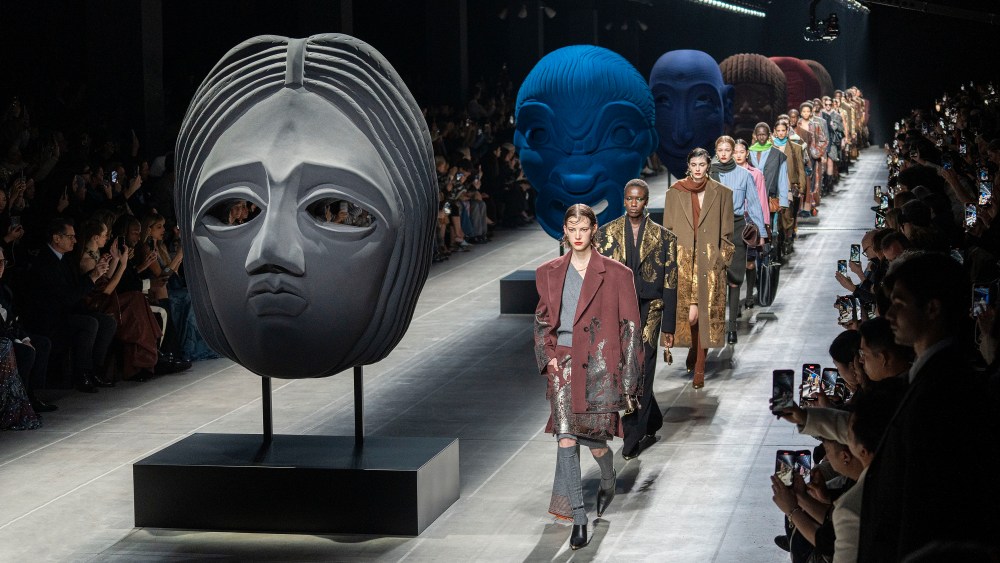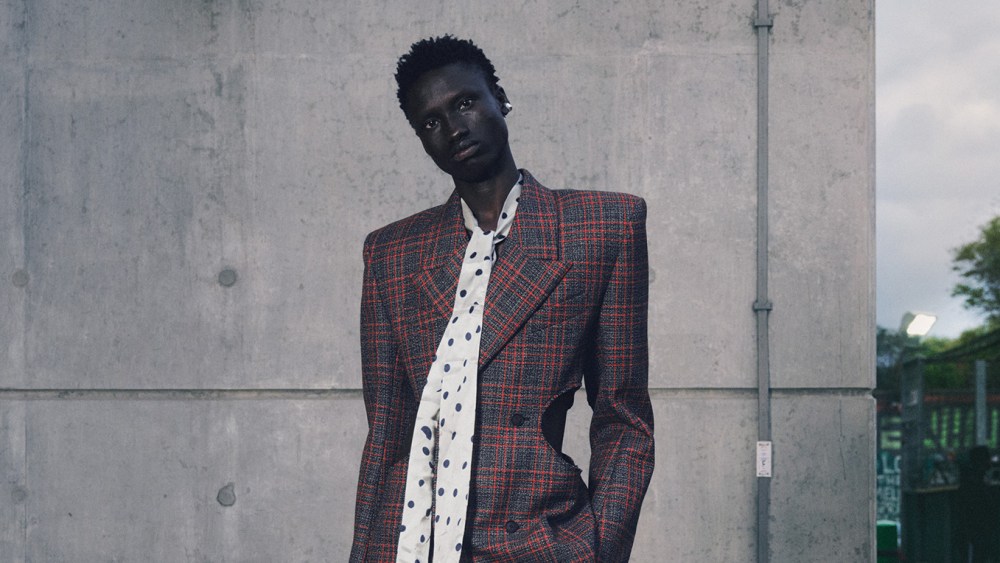The European collection season steams ahead under such a climate of creative uncertainty and upheaval that attendees are likely to train one eye on the runway and the other on their news feeds.
Studio teams will unveil spring 2025 collections at Chanel, which is searching for a creative director following the sudden exit of Virginie Viard last June; at Dries Van Noten, where the founder decided to retire from the runway and his successor has yet to be named; at Y/Project, where Glenn Martens recently stepped down after an 11-year tenure, and, revealed on Tuesday, at Jean Paul Gaultier, where Florence Tétier has departed.
Design teams are also taking the lead at Tom Ford, awaiting the arrival of Haider Ackermann at the creative helm following the ouster of Peter Hawkings, and at Lanvin, awaiting the arrival of its new creative director Peter Copping.
You May Also Like
More possible vacancies are on the horizon: The employment contracts of Hedi Slimane at Celine, John Galliano at Maison Margiela, Jonathan Anderson at Loewe, and Lucie and Luke Meier at Jil Sander are coming to term before the end of the year or in early 2025, sources told WWD.
It is understood talks are ongoing, but the possibility of renewals could not immediately be learned.
Speculation is also intensifying that potential successions are looming in the not-too-distant future at Fendi on the women’s side, Gucci and Missoni, which have not yet galvanized winning formulas under the design stewardship of Kim Jones, Sabato De Sarno and Filippo Grazioli, respectively. Rumors also hover around the future at Etro, designed by Marco De Vincenzo.
Some consider Burberry another question mark, with sources describing Daniel Lee’s spring 2025 show, staged Monday at the tail end of London Fashion Week as something of an audition to convince new chief executive officer Joshua Schulman that the designer has the chops to improve fortunes at the stalled British house.
The flurry of creative switches comes amid a backdrop of slowing luxury consumption worldwide, especially in mainland China and the United States.
Shorter Tenures Than Ever
All those searches, and potential future ones, highlight the trend to shorter designer tenures at Europe’s heritage houses. (A WWD analysis of designer appointments last year showed that roughly half the creative directors at 40 houses have been in their positions for five years or less.)
“It looks like we may have come to the end of a cycle: For the first time in about 15 years, luxury fashion as a whole slows down, especially in the regions which sustained its growth,” said Benjamin Simmenaueur, director of research and professor at French fashion school IFM, an acronym for Institut Français de la Mode. “I think some of the recruitments are triggered by the new pressure to deliver in a very uncertain context.”
In his view, the current model adopted by most luxury brands — developing a “very exclusive storytelling about craftsmanship and excellence while at the same time targeting the aspirational clients with heavily branded entry-price products, celebrities and influencers marketing” — is not so desirable anymore.
Massimiliano Giornetti, director of Polimoda in Florence, blamed post-pandemic consumer euphoria, which “led analysts and merchandisers to think that double-digit growth could support a huge increase in prices and margins. This has not been the case. The consumer today is faced with products that have doubled [in price] over the course of four seasons without any real improvement in quality.”
Concern about this slowdown has led to “pointing the finger at poor strategic vision by creative directors, without however taking into consideration that behind their work there are marketing, communication and merchandising strategies shared with the CEO and management,” Giornetti said.

According to Giovanna Brambilla, partner at Milan-based executive search firm Value Search, the luxury industry is going through a transformation phase “because consumers are changing their lifestyles very rapidly and their priorities, from goods to service, from product to experience. This means brands need to change their value proposition, the strategy to engage consumers and often the image of the brand and the creative content of the product.”
Searching for a New Image
Brambilla believes this has led to the recent changes in creative direction that “represent the evidence that brands are looking for a new image, a more contemporary product and a different customer target, but also a different range of values to telegraph to customers, current and potential.”
Mathias Ohrel, founder of m-O, a Paris-based recruitment firm in the luxury sector, argued that “agility is more than ever an essential quality for the survival of brands. Brands are living entities on the move, which like humans find their balance by moving forward. The business leg must go at the same pace as the creative leg, to maintain this balance.”
Marco Pecorari, assistant professor and program director of the master of arts in fashion studies at Parsons Paris, argued the revolving door of creative leaders is mostly tied “to a commercial need to keep renewing the image of a brand as a marketing strategy.”
Like ‘An Earthquake’
Indeed, the arrival of a new creative director at a brand is paramount to an “earthquake” inside the brand.
“While we could say that disruptions and crisis can sometime stimulate creativity, a constant change of paradigm may not be beneficial for the quality of the products and creations,” Pecorari cautioned. “In all honesty, I think that creativity can also be developed through a consistent and long engagement with the house and its languages.”
Mary Gallagher, Paris-based associate of boutique recruitment firm Find Consulting, noted that creative director changes often follow the change of a CEO, who is typically “under enormous pressure to exponentially increase revenue in an unrealistically short period. The 2024 downturn in luxury has exacerbated this pressure.”
Exceptions to the rule include Hermès, Brunello Cuccinelli, Loro Piana and The Row, among others.
“In many of these cases, the company executives are ultimately the creatives, or they steer the studio, so their vision for the brand is consistent and unified,” Gallagher said. “Craftsmanship and incremental innovation allow them to appeal enduringly across generations. They trade in the attitude of a best-kept secret.”
By contrast, brands that play in fashion must accept change as the lifeblood, so they join “in a race to attract customers, skew younger, milk data and constantly do storytelling,” she said. “Changes do sometimes come in waves and this is one of those periods.”
Gallagher urged companies to give more time to the designer, “who’s often responsible for product, brand image, and most of what the customer experiences physically, visually and even emotionally. Creatives need commitment and support from the business in order to imagine, invent, produce and succeed.”
Similarly, Value Search’s Brambilla noted that some creative directors have also been focused on protecting the heritage of brands, pointing to innovation that is not at all costs and not disruptive, citing Alessandro Michele re-elaborating vintage Valentino looks for his first pre-collection, De Sarno at Gucci, and Chemena Kamali at Chloé.

Polimoda’s Giornetti characterized the “schizophrenic dance,” or revolving doors of creative directors, “as simply the demonstration of an absolute blindness on the part of big brands in which the only objective is a sudden change of creative director, without the vision of linking this choice to the real needs of the maison.”
He argued that this has led to “unpersonalized brands, deeply deprived of soul and identity. A vain global attempt to reach an increasingly younger and by definition totally disloyal community of consumers, without understanding that fashion has moved from being a status symbol to a symbol of an individual expression.”
Rodgy Guerrera, founder of boutique head hunter Rodgy Guerrera & Partners, said “the intense focus on sales figures can sometimes detract from representing the brand’s aesthetic and core identity. In the rush for financial success, the brand’s DNA may be overlooked.”
This leads to a “new normal” of shorter creative tenures, she said.
The Need to Slow Down
“Perhaps the industry should slow down and give creative directors the time and space to do what they do best — create,” Guerrera said. “They need support from management teams and a shared vision to succeed. Otherwise, the problems lie not with creativity, but with the structure of the company itself, which may ultimately hinder long-term success.”
Paola Cillo, associate professor of management and technology at Bocconi University, believes the shorter tenure of creative designers “is here to stay,” driven by “a push from the market” triggered by technology and social media causing “a sociological change in consumer needs,” that leads to changes at the organizational level.
“Consumers have been educated to planned obsolescence, and to accept and embrace change at a much faster pace than in the past,” Cillo opined. “Also, this is a time in which companies need to address different (potentially five) generations of consumers at the same time, each of them with different values, ambitions, desires, and stories. Therefore, companies have been somehow forced to change and to experiment more than in the past, even when this change was not in their DNA, and to do so at the core of their business, which is the creative leadership.”
Cillo believes “change is always an opportunity to do things in a new and, eventually, better way,” especially when designers bring experience built outside their birth country, cross-pollinated by different cultures, experiences and education.
It is key, however, for designers to be respectful of the brand values, know-how, heritage, image, craftsmanship and codes, she continued. “What is not positive is the change for the sake of change, without a strategy, without a purpose, without an evolution. This latter type of change can be dangerous for the fashion house and for the designer as well.”
Observers said they expect brand stewards to choose from myriad creative profiles, depending on their strategy, and the chief business challenge to overcome.
Parsons’ Pecorari described an “elastic nature” to brands and their internal teams today.
“This foundation has allowed them to shift quickly and even enlarge the scope of what is an artistic director in fashion today,” he said. “After music (Pharrell Williams is now men’s artistic director at Louis Vuitton), I think it would be interesting to see other figures from other fields joining brands as artistic directors. I am thinking about movie directors, for example.”
Nevertheless, he stressed that “more than ever, technical knowledge will be a key to the success of new directors because, despite the flatness of fashion dictated by social-media control, in the long term what remains will always be the handmade and industrial quality of creation and production.”
According to Ohrel, “Household names are proven commodities, both in their image and sales potentials. Number two talents may be interesting in maintaining a consistent creative vision while leaving more power in the hands of the leadership team. Image being one of the key factors in the success of any brand, it is of course mandatory for any creative director to have a vision on this dimension of a brand.”
He held out hope that “French fashion flagships like Chanel or Dior, unlike luxury houses born from leather goods whose center of gravity has shifted from the product to the image, always recruit designers who know who they want to dress, have experience in creating a wardrobe, and are capable of maintaining and developing the know-how of the brand entrusted to them.”
IFM’s Simmenaueur agreed that “it will be a good thing if it really means new creative directions will finally happen. If it is just another game of musical chairs, not so much.”



